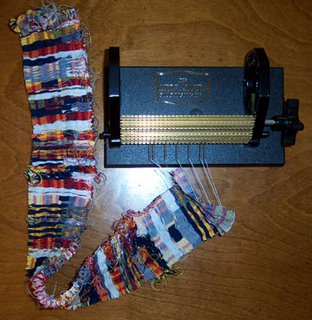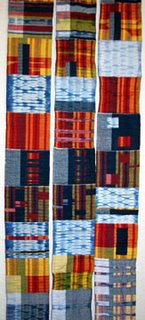Sorry for the lapse in posting -- we went to Vancouver for a few days. When I returned, there was an e-mail from Kathy Murphy (AKA "Supa K," the Loom & Shuttle Guild Newletter Editrix) that the June 2006 guild meeting will be a celebration of the contributions of longtime member, Mary Schwartz, who is 100 and has been a member of Loom & Shuttle since 1949. Mary is always so kind and willing to share her latest creative endeavors with the guild. I think it's great that she's being honored. Happy birthday Mary, & thanks for being so welcoming when I joined Loom & Shuttle and for continuing to welcome new members!
While Doug and I were in Vancouver, we went to Granville Island, which is a successful experiment in urban redevlopment that appears to have a little bit of everything, e.g., some artisan worshops, a public market selling food that locals buy, the Emily Carr Institute of Art & Design, and even a cement factory. Of course I was interested in going into the fiber studios. Among the fiber studios was the Textile Context Studio at which there was an interesting piece that was a globe that opened up and had mutiliated world currencies inside. To me this piece was very loaded, with references to money, power, etc.
We also went to Maiwa Handprints, which supports artisans around the globe. We got a few pillowtops embroidered by members of the Kutch Mahila Vikas Sangathan coop in western India. It's interesting--I ordinarily hate shopping because I feel as though big money is telling consumers that they need to buy in order to stay au courant; however, I can shop for textiles & books for hours. I enjoyed this store without my itching to get out after 5 minutes.
I also was interested in going into the Silk Weaving Studio, as I had never seen a weaving business. I was curious to see this business because I weave for the pleasure & mental challenge, rather than for income. There were four looms in the studio, as well as yarns & finished goods for sale. There were a few garments and a number of scarves for sale. When I left the studio, I couldn't help but wonder if scarves are the only viable weaving option for a North American weaver who wants to earn a steady income by weaving. I'm theorizing this because textiles are so undervalued in North America; however, I think that a person might be willing to spend a few hundred dollars for a special piece, and a scarf can be purchased for a few hundred dollars. So, I'm proposing that scarves are the most efficient thing to weave for those who wish to at least recoup the cost of materials. I've only sold one commissioned piece in my history and haven't offered my other pieces for sale because I weave for my own exploration and enjoyment. Also, I don't think that the majority of people in North America would be willing to pay what a piece actually is worth (e.g., when I had to list the insurance value of one of my strip weavings that was going to be in a show, I wrote several thousand dollars as the value). I do give away pieces, though -- I think that money taints the exchange in terms of expectations, resentments, etc. Also, is it possible to put a monetary value on something one loves to do? Does the placement of the monetary value make the activity become something less-loved? Any thoughts on this, readers?
Finally, when I was on the way to Vancouver, I finished sewing together the three triple weave strips. After doing this, I realized that I need about 10 more strips. So, I'm back to the loom. (Currently, this is about a $6K piece, if one's putting a monetary value on the piece.) Anyway, here are photos of the full piece to date & a detail:
I dyed the 2nd & 3rd strips in a different dyebath than the first one using the Bren formula of non-measurement, so I'm lucky that the color matches pretty well.
As a final comment, I hope that you're checking out the comments on this blog, and please feel free to comment. Among the response to my more recent posts is one by Jan Moore, in which she candidly writes about how her textiles reflect her personal experiences. Also, Pennita Peters raises that art/craft question. It's a good point she raises -- do I consider my one-offs to be art, while the other numbered pieces are craft? I've always been more interested in process rather than product, and I think that I number my strip weavings to show the history and progression in my process. For example, the triple weave strip weaving that I'm working on is currently called: "Strip Weaving 4: Shibori Strip Weaving 3: Japanese, Kente, Resist Triple Weave Strip Weaving" (For lack of better terms & because of the textiles evoked for me, I used the term "Japanese" to refer to the section that is 1/3 white & 2/3 blue, while "Kente" refers to the striped sections. The jury is still out on if I'm exoticizing these cultures' textiles by this nomenclature. Thoughts on this are welcome too.)
Until next time,
Bren







